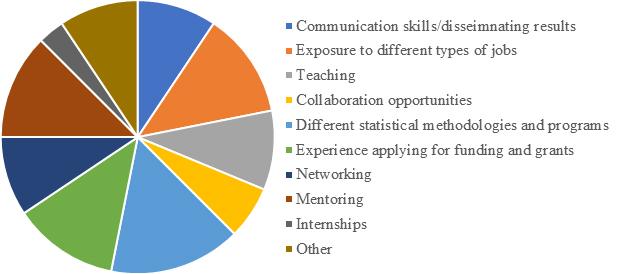In last month’s issue of SPSPotlight, we asked our readership to identify areas in which they would like to acquire further training. Our sample (N=10) was mostly based in North America (90%). Results are depicted in the pie chart below.
- Wanted to sharpen their communication skills (3)
- Wanted greater exposure to various types of jobs available to PhD graduates (4)
- Wanted more training in teaching (4)
- Wished they had more collaboration opportunities (2)
- Said they did not have sufficient statistical training (5)
- Wanted to learn more about applying for funding (4)
- Wished to network more (3)
- Wanted to learn more about mentoring (4)
- Wished to have more internship opportunities (1)

What do we take away from this? Evidently, the needs of graduate students are varied. There is no answer that might fit all. Different programs of graduate training may each contain strengths and weaknesses. Then, each individual student’s needs vary in relation to their own skills and weaknesses. Another contributing factor is that each research program may be unique and its implementation may require different skills.
What can we do to account for these gaps in graduate training? Although one institution may not always be able to provide students with all the skills necessary, it is important to remember that there are resources available for students. Sometimes these resources may be accessible at a very low cost or even for free.
Below are some ways SPSP might be helpful to students in these various areas:
- If your goal is to refine your communication skills and learn how to efficiently disseminate your research, attending the SPSP annual convention is a great opportunity. (Note: Submissions for the upcoming 2020 convention will be accepted from July 8 to July 23, 2019).
- The annual convention is also a great place for networking, which can lead to collaboration opportunities.
- If you are interested in getting to know more like-minded graduate students, SPSP offers various summer opportunities that are not to be missed, including SISPP, EASP, SASP, SPUR, and SPF.
- If you are interested in learning about non-academic job opportunities, there are various exhibitors (e.g., Facebook, Uber) at the annual conference that may be informative. Some of these programs also offer internships.
- The SPSP Career Center features both academic and non-academic job openings and internships.
- SPSP offers free online webinars throughout the year on various topics that may just be a skill that you are yearning to learn! Recent webinar topics include Bayesian statistics, turning your CV into a resume, and introductions to R Markdown and multilevel modeling. The next webinar on the topic of “applying for positions at teaching-focused institutions” will be held July 30.
- In general, the SPSP website is a great place to learn more about tools available for students, including a full page of funding resources, a page featuring the various statistical tools and methods, and a page for teaching resources, including syllabi and demos.
All in all, it is perfectly ok to feel as if you are lacking training in one area or even a few areas. There is always room for improvement. A first step is to identify these areas and to speak to your advisor. Together, perhaps you can brainstorm possible ways to acquire the desired skills.
As outlined above, SPSP is one source offering numerous resources for students. Other societies like SPSP may offer similar resources. Therefore, it is important to actively search for resources. Oftentimes there is a way for you to gain the knowledge you wish to learn.




